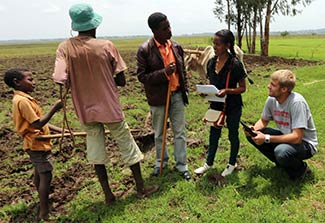Because of a lapse in government funding, the information on this website may not be up to date, transactions submitted via the website may not be processed, and the agency may not be able to respond to inquiries until appropriations are enacted. The NIH Clinical Center (the research hospital of NIH) is open. For more details about its operating status, please visit
cc.nih.gov. Updates regarding government operating status and resumption of normal operations can be found at
opm.gov.
Opinion: Academia can benefit from engaging in global health
May / June 2019 | Volume 18, Number 3
by Fogarty Director Dr Roger I Glass
Why should an academic health center engage in global health? There are many potential benefits - to satisfy student demand and better prepare them to be global citizens, attract and retain excellent faculty, win increased grant funding, expand the organization’s philanthropic base, advance scientific discovery and enhance the overall educational experience.
Of course, there are barriers as well - physicians’ time is precious and it’s costly to provide them with opportunities that take them away from clinical duties. In some institutions, global health activities are not viewed as valuable learning experiences, and there may be accreditation issues - but with the commitment of leadership - these can be overcome.

Photo courtesy of Ohio State University
Working in a low-resource setting overseas can provide global
health students with unique transformational learning
opportunities that produce valuable insights.
We know that wherever a global health program is launched, administrators have seen a huge surge of student interest in enrolling. A growing number of students and faculty say they are even selecting institutions based on the foreign experiences they offer. Working in a low-resource setting overseas not only helps students and faculty develop a global mindset, it also sensitizes them to different cultures, equity issues and the social determinants of health. These immersive experiences can provide unique transformational learning opportunities that produce valuable insights. Participants are able to enhance their ability to recognize, diagnose and treat diseases that are rarely seen at home. They’re forced to adapt to the challenges of working in low-resource settings, which can open their mind and encourage flexibility and creative thinking. Perhaps more importantly, global health engagement reinforces the values of the medical and public health professions, and affords the opportunity to engage in rewarding work, which helps prevent burnout.
Global health expands the synergy between training, service and research - the cornerstone of academic medicine. It broadens the horizons for the type of research that institutions can conduct. That, in turn, creates new opportunities to compete for the growing portion of the NIH budget that supports global research. It also enables bi-directional learning by exposing students and faculty to new approaches and different ways of thinking.
By taking science where the problems are there is much we can learn. For instance,
retinoblastoma is more common in India than anywhere else in the world. Why is that? What can we learn from conducting studies there? In a similar vein, there is an extended family in Colombia with an inherited form of early-onset Alzheimer’s disease. By establishing research partnerships and helping to build capacity there, we are enabling scientists to investigate how this terrible disease might be halted at its earliest stage. Imagine the immense savings - both financial and in terms of human suffering - a cure could bring.
We’ve seen that many
breakthroughs in the treatment and prevention of HIV/AIDS were made in low- and middle-income countries (LMICs), and these inform our domestic response to the ongoing epidemic in U.S.
As our own medical costs continue to skyrocket, we’ve begun to look overseas for more economical - yet equally effective - approaches to treatment. For instance, the standard of care for children with hydrocephalus in the U.S. used to be surgically implanted shunts. But it’s expensive to place the shunts and they require revisions as the child grows. From research in Uganda, we now have proof that a
simpler, more cost-effective treatment is possible. It’s now being adopted in the U.S. and has the potential to save more than a billion dollars a year.
Previous discoveries made in low-resource settings have revolutionized treatment worldwide. For example,
oral rehydration therapy was discovered in Bangladesh during a cholera epidemic. It’s a simple solution that is estimated to save a million lives each year. Earlier studies conducted in Uganda identified the first viral cause of cancer and led to the first successful chemotherapy treatment.
By engaging globally, we can also help ensure disease outbreaks are contained locally with improved surveillance and research skills. With the increasing frequency of travel, diseases such as SARS, MERS and Ebola are a concern to us all.
For institutions considering their bottom line, global health can also prove to be a wise investment. Many philanthropic funders are interested in global health, which can diversify the donor base and enable growth. Global health activities can also expand the number of NIH and other research grants an institution can receive, creating jobs on campus and boosting the local economy. About
90% of every dollar the U.S. government invests in global health research and development goes to U.S.-based researchers. That generated an estimated 200,000 new American jobs and $33 billion in economic growth from 2007 to 2015,
according to the Global Health Technologies Coalition (GHTC).
Measured another way, global health programs can attract and engage top-tier students with a passion for international work, and global health in particular. Many have described their field experiences as “life changing.” After all, how can we put a price tag on the opportunity to improve the lives of the world’s most vulnerable people?
More Information
To view Adobe PDF files,
download current, free accessible plug-ins from Adobe's website.